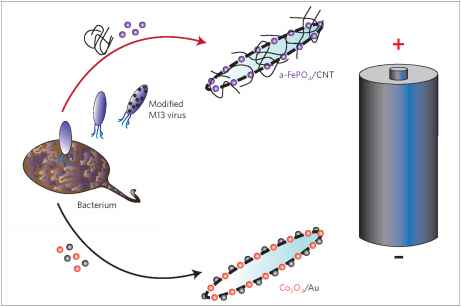In 2009, Angela Belcher, a professor of bioengineering at MIT, made a special trip to the White House to show a new type of battery for the new President Obama. What on earth did this battery actually make the president so interested in? It turned out that Belcher mastered the new lithium battery positive and negative electrode manufacturing technology, but one of the materials is not from the periodic table, but the color-changing "virus" we talk about.
This engineering breakthrough is not only expected to reduce toxicity during battery manufacturing, but also improve battery performance. At that time, Obama was preparing to invest $ 2 billion to advance the progress of battery technology, and Belcher's "viral" battery is one of the future trends.

Ten years later, Belcher's "virus" battery has also made rapid progress. The virus she makes can be used with more than 150 different materials. Belcher also successfully proved that his technology can be used to manufacture other materials, such as solar cells. Of course, Belcher's desire to use a virus to drive electric vehicles has not been realized, but this technology is not far from getting out of the laboratory.
Viruses called micro-zombies in nature also have the ability to bridge the gap between life and death. They have complete genomes and are outright creatures, but unlike other organisms, they cannot reproduce without a host. However, in Belcher's view, these characteristics can be used in nano-engineering, while improving battery energy density, life and charging rate, while reducing pollution in the manufacturing process.
"In the field of batteries, more and more people are beginning to explore positive and negative materials in the form of nanostructures," explains Konstantinos Gerasopoulos, senior research expert at the Johns Hopkins Applied Physics Laboratory. "We can use a variety of conventional chemical techniques when preparing nanomaterials. As for biological materials such as viruses, the advantage is that they already exist in the form of" nano ", so they are essentially natural templates or scaffolds for the synthesis of battery materials.
The magic of nature has given birth to many methods, without the help of viruses, you can use inorganic materials to build useful structures. Belcher's favorite example is stone cassia (a type of shell), which is highly structured at the nanoscale, light and strong. After tens of millions of years of evolution, the protein produced by Shi Juming DNA can extract calcium molecules from the mineral-rich aquatic environment and deposit them in an ordered structure layer in their own bodies. Although no one uses cassia to make batteries, Belcher realizes that we can use the same basic process in viruses to make useful materials for humans.
"We have been trying to control nanomaterials that cannot normally be manufactured by biotechnology through bioengineering," Belcher said. "We have expanded our biology toolbox to handle those new materials."
The virus selected by Belcher is the bacteriophage M13, which is a cigar-like virus that can replicate in bacteria. Although it is not the only virus that can be used for nanoengineering, Belcher believes that it is the best choice because the genetic material of M13 bacteriophage is easy to manipulate.
In order to summon the virus to produce electrodes, Belcher exposed it to materials that she wanted the virus to manipulate. Natural or engineered mutations in some viral DNA can cause them to lock onto the material. Subsequently, Belcher extracted these viruses and used them to infect bacteria, producing millions of copies of the same virus. This process is repeated over and over again, and with each iteration, the virus has slowly evolved into a battery architect with precise adjustments.
Belcher's genetically modified viruses can't tell the positive and negative of the battery, but this ability is not important to them. In the settings, their DNA only needs to solve simple tasks, but if millions of viruses engage in "poisonous sea tactics", they can create usable materials. For example, a genetically modified virus may be modified to express only a protein on the surface that attracts cobalt oxide particles to cover its body. Other proteins on the surface of the virus attract more and more cobalt oxide particles. This forms a cobalt oxide nanowire, which is composed of connected viruses and can be used for battery electrodes.
Belcher's process matches DNA sequences with elements in the periodic table of elements to form an unnaturally-selected accelerated form. One-way coding of DNA may cause the virus to lock onto iron phosphate, but if the code is adjusted, the virus may be more interested in cobalt oxide. This technique can be extended to any element in the periodic table, as long as the matching DNA sequence is found. From this perspective, Belcher's work is not much different from the selective breeding of pet dog lovers. The latter is responsible for creating the perfect dog, and such dogs cannot be created by nature. However, Belcher is not breeding poodles, but breeding virus-producing batteries.
In short, Belcher is using her virus assembly technology to create electrodes and using the technology in a range of different battery types.
At that time, the battery she demonstrated for Obama was a standard lithium ion button battery, just like the one used in quartz watches. However, in most cases, the electrodes used by Belcher have more peculiar chemical properties, similar to lithium air and sodium ion batteries. She pointed out that this is because it does not make much sense to compete with mature lithium-ion battery manufacturers. "We are not trying to compete with the current technology." Belcher said. "We are working on a question," Can biology be used to solve some problems that have not yet been solved? "
Of course, one of the promising applications is to use viruses to create highly ordered electrode structures to shorten the path of ions through the electrode. Paul Braun, director of the Materials Research Laboratory at the University of Illinois, said that this will increase the charge and discharge rate of the battery, which can be called "one of the stunts in the field of energy storage." He also pointed out that, in principle, virus assembly can significantly improve the structure of the battery electrode and increase its charging rate.
Right now, Belcher's virus assembly electrodes are basically random in structure, but she and her colleagues are working to guide the virus into a more orderly arrangement. Despite this, her viral battery's performance is still better than traditional electrodes, such as higher battery capacity, cycle life and charging rate. But Belcher still emphasized that the biggest benefit of virus assembly technology is its environmental protection properties. Traditional electrode manufacturing technology requires the use of toxic chemicals and high temperatures, and Belcher only needs electrode materials, water at room temperature and some genetically modified viruses.
"My laboratory is now most concerned about clean energy technology." Belcher explained. This covers issues such as the source of the electrode material and the waste products resulting from the manufacture of the electrode.
Belcher's viral battery has not been officially commercialized, but she and her colleagues recently published several papers (under review) detailing the commercial application prospects of this technology in energy and other industries.
When Belcher first proposed the use of viruses to make something useful to humans, she was suspected by many colleagues. She recalled: "People say I am crazy."
Now, this idea does not seem to be far-fetched, but bringing the technology from the laboratory to the real world is not so easy. "Traditional battery manufacturing uses inexpensive materials and processes, but it takes years of research and related costs to improve performance and solve mass production problems through viruses," explained Bogdan Dragnea, a chemistry professor at Indiana University Bloomington. "It was only recently that we understood the potential of virus-based materials from the perspective of physical properties."
Based on virus battery technology, Belcher has established two companies. One is Cambrios Technologies, established in 2004. The company uses a new manufacturing process to produce electronic components for touch screens. As for the second company, Siluria Technologies, it uses viruses in the process of converting methane to ethylene, a gas widely used in manufacturing. In addition, Belcher also uses viruses to assemble solar cells, but the efficiency of this technology is temporarily insufficient to compete with the new perovskite solar cells.
Of course, it remains an open question whether the virus's participation in making electrodes can meet the standards of commercial production. Gerasopoulos said: "A lot of materials will be invested in battery production equipment, so it is not easy to reach the level of biomolecules." Fortunately, he does not think that the obstacle is insurmountable, but "so far , Which is probably one of the most important challenges. "
Even if we can never drive a virus-driven Tesla, Belcher's bio-driven nano-engineering technology has a bright future in areas unrelated to electricity. At the Massachusetts Institute of Technology, Belcher is working with a team of scientists using virus assembly technology to generate tumor-tracking nanoparticles. These nanoparticles are designed to track cancer cells that are too small to be detected by doctors, which can greatly improve the early detection of cancer patients and reduce mortality. In addition, these particles can also be armed with biological materials that can kill cancer cells, although this target is still far from us.
In human history, viruses have been a precursor to disease and death, but Belcher's work has guided the future for us. It turned out that these grim reaper guys can really be used by people.
3D Acrylic Edge Banding with Double Color Edge Banding and one color edge banding. Solid color and woodgrain design all be supported. Perfect transparent surface. Japan Acrylic raw material. German ink and JOWAT primer. Customize color and size for Acrylic edge banding. Sinowolf Plastic Dekor CO., LTD always focus on producing best quality edge band. Using high-end raw materials, all chemical additives import from Europe, to make sure our plastic edge banding keep stable quality 3-5 years. Our products range include PVC edge band, ABS edge band, 3D PMMA acrylic edge band, Aluminum edge band.

3D Acrylic Edge Banding
3D Acrylic Edge Banding Series,Plastic 3D Acrylic Edge Banding,Multi-Color Acrylic Edge Banding,3D Furniture Acrylic Edge Banding
Sinowolf Plastic Dekor Co., Ltd , https://www.sinowolfdekor.com